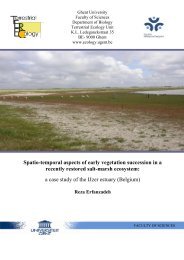PhD Arthur Decae 2010 - Ghent Ecology - Universiteit Gent
PhD Arthur Decae 2010 - Ghent Ecology - Universiteit Gent
PhD Arthur Decae 2010 - Ghent Ecology - Universiteit Gent
You also want an ePaper? Increase the reach of your titles
YUMPU automatically turns print PDFs into web optimized ePapers that Google loves.
metatarsi I & II, but they may or may not extend onto the tibiae. In some species the typical<br />
scopula-hairs are replaced by dense pubescence on the anterior tibiae, thus forming a distinct<br />
pseudoscopula (<strong>Decae</strong> 1995). Spines: Descriptions of spine patterns are a major source of<br />
confusion in Nemesia taxonomy. Owing to their conspicuous presence, spines and spine<br />
patterns were used extensively as discriminative characters at the species level in early<br />
literature. Usually these patterns were reported in the form of descriptions where figures<br />
would have been less ambiguous. In more recent literature (Blasco 1986a; Cardoso 2000)<br />
spine patterns in Nemesia have been regarded as taxonomically virtually useless, owing to<br />
their extreme variability down to the individual level where different spine patterns are<br />
frequently found on the left and right sides of a single spider. However, on certain faces of<br />
some leg and palp segments, spine patterns may contain useful taxonomic information. Here<br />
the prolateral spine formulae for all patellae are given (PSP, PSPvar), and those on patella III<br />
and tibia III are figured (Figs. 17, 30, 37, 44, 51, 58, 65).<br />
Leg IV: The relative lengths, measured<br />
along the prolateral margin of the<br />
metatarsus, tibia and femur, are of<br />
diagnostic value at the species level and<br />
are given in the ratios M4:T4:F4 (Fig. 5).<br />
Metatarsal combs: The metatarsal<br />
preening combs on legs III and IV that<br />
were reported to be of diagnostic value in<br />
Nemesia by Raven (1985: 96) are<br />
unambiguously found only distally on<br />
metatarsus IV in three Balearic species (N.<br />
ibiza, N. randa and N. bristowei).<br />
Spinnerets: The spinneret morphology of<br />
Nemesia shows important, but so far<br />
underrated, taxonomic characters for<br />
species level taxonomy. The PMS may be<br />
absent as in N. brauni (Fig.18), reduced,<br />
having none or few apical spigots as in N.<br />
bristowei (Fig. 31), or fully functional,<br />
having spigots distributed over the distal<br />
and ventral surface as in N. seldeni (Fig.<br />
52). The PLS also show variation,<br />
particularly in the spigot development on<br />
the ventral surface of the basal segment.<br />
Spigots may be absent, restricted to the<br />
distal half of the segment (most species),<br />
or distributed widely over the ventral<br />
surface of the segment as in N. seldeni<br />
(Fig. 52). Finally, the apical spigots on the<br />
distal segment of the PLS may also show<br />
important differences between species. All<br />
species have a dense field of spigots at the apex of the PLS that are roughly arranged in<br />
circular concentric rings of smaller spigots on the periphery around larger spigots more<br />
centrally, with a few distinct "macro-spigots" in the centre. The number of macro-spigots can<br />
be of diagnostic value. Spermathecae: The receptacles of the spermathecae provide a key<br />
character for species identification in female Nemesia (see also Blasco 1986a). In general<br />
three broad types of shape can be distinguished: unipartite with no distinct divisions between<br />
Figs. 9-12 Nemesia brauni L. Koch, male. 9 body, dorsal; 10<br />
distal end of right palp; retrolateral; 11 ditto, prolateral; 12 leg I<br />
clasper, prolateral. Scale lines = 2mm (9), 1mm (10-12).










